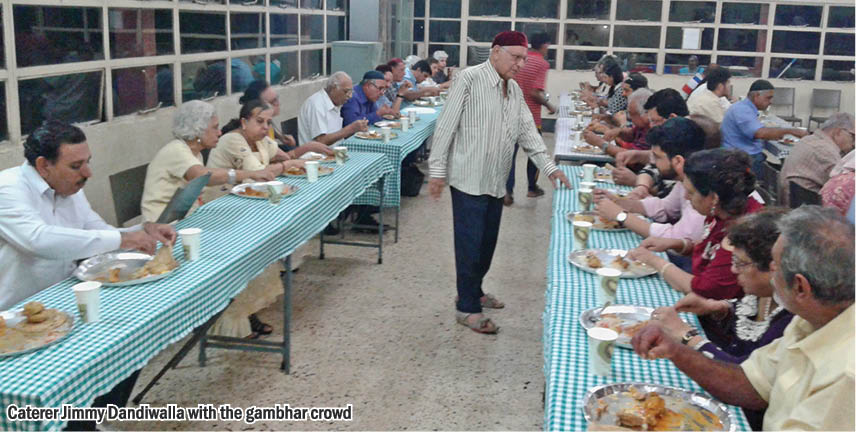In recent times, we have unfortunately reduced Gahambar to a travesty. In not-so-distant history, we have been witness to so-called Gahambars hosted by individuals who had aspired to become Trustees of certain community institutions or by those who won the elections. There is also a variety known as the ‘fee no Gahambar,’ which is a regular community dinner with a ‘cover charge’ that follows a community event. This sort of Gahambar is mainly to entice people to come for the event – generally the kind where there are a few boring speakers who wax eloquent, and lots of garlands and shawls get exchanged. Sometimes, in order to manage the crowds, there is a Gahambar only for men or only for women, as is quite common in Pune city.
Unfortunately, from what was once a pious and disciplined religious event, we have reduced Gahambar to a black comedy circus where tickets reportedly are sometimes sold in black and people shout and push each other as if they have just returned from a famine-stricken district! Perhaps, it is time for us to understand the true importance and significance of this solemn event.
Time For Collecting: Gahambar means ‘the time for collecting/storing’. Broadly speaking, it is the time for collecting or harvesting good deeds and Nature’s Blessings. Some also interpret the term as collecting of the community to offer gratitude. In modern times, a few philanthropic Parsi and Irani Zoroastrians also sponsor Gahambar in the Nayat or memory of their dearly departed, as an act of spiritual merit and to invoke blessings from and for the departed.
Six Gahambars: In the religious and traditional context, there are six Gahambars (in ancient times, the six great holidays of five days’ duration each in a year – the first four days of each Gahambar for preliminary preparation and the last day for the main feast). Gahambar should be celebrated at the correct time during the year to commemorate:
- The seasons and their regularity on which the prosperity of the world depends; and
- Ahura Mazda’s Good Creations in the order of their evolution.
The following table the six Gahambars, the time of the year when these should be celebrated and the corresponding season or creation they commemorate:
| Name of Gahambar: | Celebrating: | Creation: |
| MAIDHYOZAREM | Mid-spring: 41st to 45th day after Navroze
[Mah Ardibehesht – Roj Khorshed to Daepmeher]
|
Heavens / Sky
|
| MAIDHYOSHEM | Mid-summer: 101st to 105th day after Navroze
[Mah Tir, Roj Khorshed to Daepmeher]
|
Waters |
| PAITISHHAYEM | Autumn: 176th to 180th day after Navroze
[Mah Shehrevar, Roj Ashtad to Aneran] |
Earth |
| AYATHREM | Time of prosperity and breeding cattle: 206th to 210th day after Navroze
[Mah Meher, Roj Ashtad to Aneran] |
Vegetation
|
| MAIDHYAREM | Mid-winter: 286th to 290th day after Navroze
[Mah Dae, Roj Meher to Behram] |
Animals
|
| HAMASPATHMAEDAEM | Vernal equinox and the arrival of the Fravashi of our dear departed: 361st to 365th day after Navroze
[The Gatha days – Ahunavad to Vahishtoisht Gatha] |
Man |
An Important Religious Duty: According to the Rivayet, a Zoroastrian has six important religious duties to perform:
- Perform or participate in the six Gahambar;
- Consecrate the Rapithvin;
- Offer worship to Sarosh Yazata;
- Remember the Fravashis of the departed;
- Recite the Khurshed and Meher Niayeshes thrice a day; and
- Recite the Mah Bokhtar Niyayesh at least thrice a month.
The Minokherad (chapter IX) lists seven principal acts of righteousness, of which the first three are: Charity (Radih), Truth (Rastih) and celebrating Gahambar.
The Shayast la Shayest and the Sad-dar place the celebration of Gahambar on top of the list of religious acts of merit.
The Zand-e-Vohuman Yasna states: “It will be an evil day for the world when the Gahambar are not celebrated.” (i.e., it will be an evil day when Zoroastrians fail to offer thanks to Ahura Mazda).
Ancient (Pre-Historic) Tradition: King Jamsheed of the Peshdadian dynasty is believed to have established the tradition of celebrating the Gahambar. He is also believed to have initiated the tradition of wearing the Kusti, and the six tassels at the end of the Kusti provides the wearer (of the Kusti) the merit of associating himself/herself with the goodness of the six Gahambar.
How Gahambar Should Be Celebrated: There are two aspects of celebrating the Gahambar:
- Liturgical services (which include the Afringan, Baj, Yasna and Pavi of Gahambar); and
- Feasting (Gahambar-ni-chasni).
Traditionally, Zoroastrians contribute cash, grain, wine or manual services for the Gahambar. The poorest of poor may contribute a token piece of wood or fuel for cooking. According to the Shayast la Shayest, on returning from a Gahambar, a Zoroastrian should recite four Yatha Ahu Vairyos (the priests recite four Yatha before the Afrin of Gahambar).
The tradition of celebrating the Gahambar at the proper time should be revived wherever a reasonable number of Zoroastrians reside. According to tradition, during the Gahambar days, Ahura Mazda showers special blessings on His creations. By performing ceremonies on that day, we invoke and tap and channelize these blessings for the prosperity and happiness of the entire universe. Also, traditionally, at a Gahambar, the rich and poor sit at a common lunch or dinner table, breaking all barriers of rank and class.
Doubtlessly, a community that prays and feasts together, stays together. Conversely, a community that only believes in feasting without gratitude or thanksgiving, portends a bleak future!
- The Poison of Pessimism - 27 April2024
- Celebrating The Interplay Of Life And Fire! - 20 April2024
- Customs To Observe At Atash Behram Or Agyari - 13 April2024
